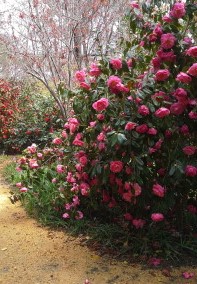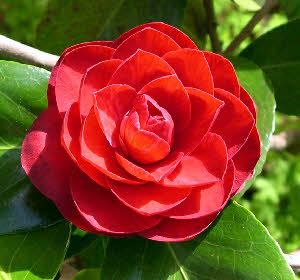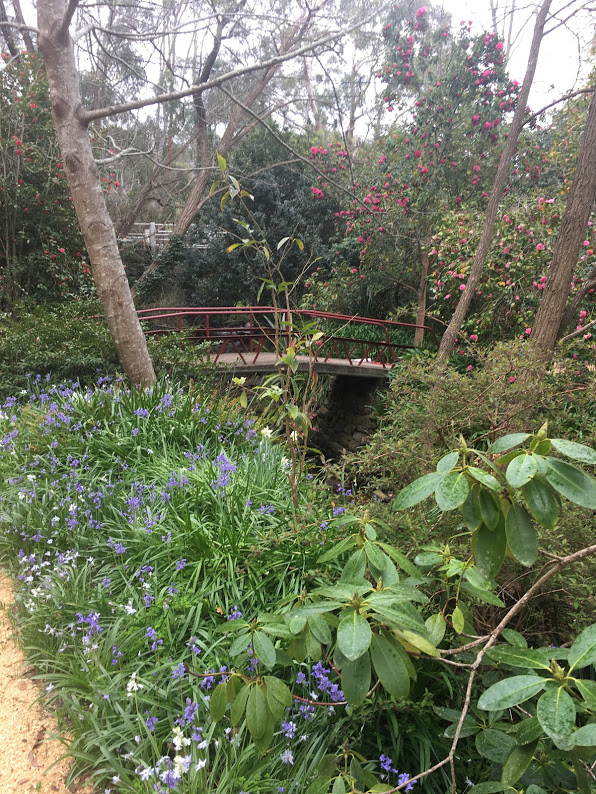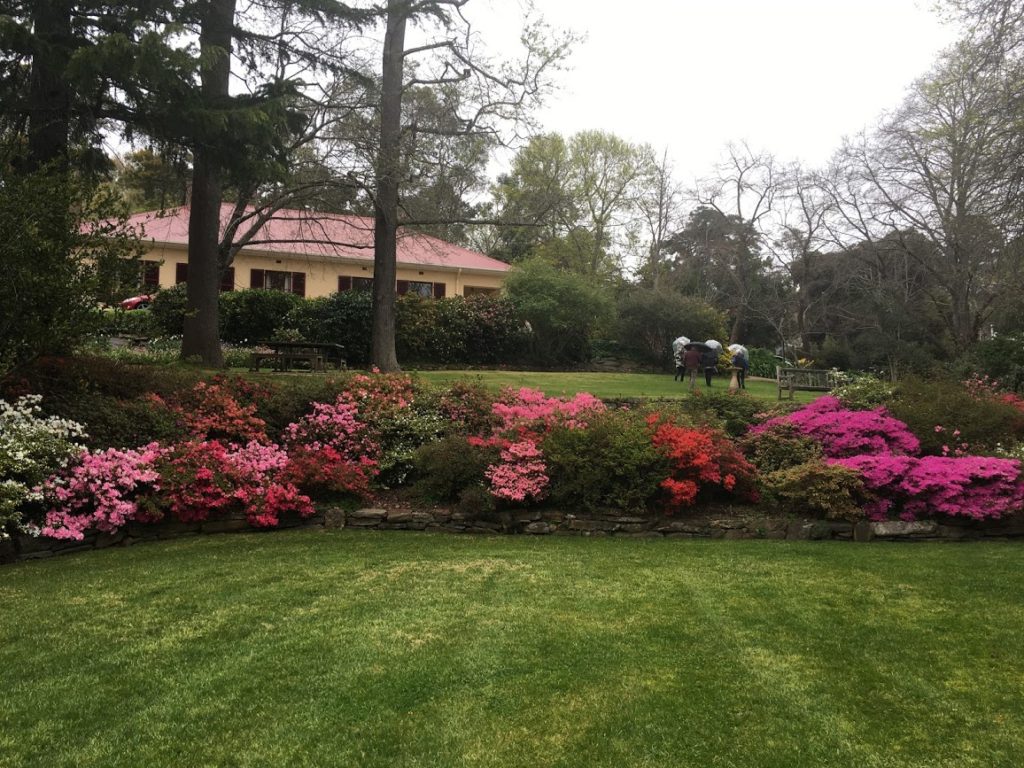The camellia against the moss of the temple, the violet hues of the Kyoto mountains, a blue porcelain cup
this sudden flowering of pure beauty at the heart of ephemeral passion: is this not something we all aspire to?
~ Muriel Barbery

In the beginning, there was dense bush land, winter creeks, deep gullies, and gum trees galore; the traditional home of the Peramangk for thousands of years.
Then, in 1836, the Europeans began to land on the beach at Glenelg, and the Adelaide Hills soon became a popular destination for these new Australians. In the early days of settlement, ‘the Tiers’ – as the Adelaide Hills were first known – were rumoured to be the haunt of bushrangers, escaped convicts and runaway sailors – our very own Sherwood Forest. In reality, there were probably fewer criminals than legend tells. Most settlers in South Australia were proud of their convict-free heritage. More were fleeing religious persecution than the law.
Germans moved deep into the Mount Lofty ranges and established towns they named Tanunda, Hahndorf, and Lobethal, planting vines and building churches. The English stayed closer to the city, planting orchards and building railway stations in towns they called Stirling, Piccadilly, Norton Summit. Wealthy Adelaide residents built summer houses in the hills to escape the debilitating heat on the plains, much as the British in India were doing among the foothills of the Himalaya. (Although Mount Lofty, at little over 700 metres, has no hope of competing with Everest’s 8,848 metres in the highest mountain stakes.) Day trippers from the city packed picnic baskets and headed for the hills too, and it wasn’t long before these picnic parties were as popular as winery tours are now.
Today, it is a cool, blustery day in September, the sky intermittently weeping gentle tears, and I have driven into the hills without a picnic basket, but in anticipation of morning tea and a tour of the gardens at Stangate House.

Stangate House was built in 1940 in the heart of Aldgate village. Owned by the National Trust of South Australia, it is renowned as a premier camellia garden, designated in 2012 as an ‘International Camellia Garden of Excellence.’ The garden also contains one of Australia’s oldest and largest oak trees, believed to have been planted in the 1860s by Richard & Sarah Jane Hawkins, who had built the nearby Aldgate Pump, a pub still popular over 150 years later.
The land on which Stangate House was built was bought by Florence Emily Thomas, in 1892. Florence was the granddaughter of Robert Thomas, an ancestor of mine, too, as it turns out, who brought his family to South Australia on ‘The Africaine’ in 1836. Co-founder and proprietor of one of SA’s first newspapers, both his son William and his grandson, Sir Robert Kyffin Thomas would follow in his footsteps. In the meantime, his granddaughter erected a small wooden cottage on her four acres in the hills and presumably enjoyed the fresh air and cooler summers among the gum trees.
When Florence died, in 1922, she was able to leave the entire property to her own daughter, Florence Gwenyth Thomas, thanks to the introduction of the Married Women’s Property Act in 1883.
Florence Gwenyth Thomas travelled to England sometime after her mother’s death, where she married the Reverend Raymond Cornish on August 5th,1927 at Southwark. The newlyweds then moved to Stangate, on the southern side of Westminster Bridge, while the Reverend Cornish was chaplain at nearby St Thomas’s hospital.
The couple stayed on in London until the late 1930s. Then, with the threat of another war giving everyone goosebumps, they decided to return to Australia, to the property at Aldgate that Gwenyth Cornish had inherited from her mother. A house was designed for them by Adelaide architect, Eric H. McMichael, based on a model the Reverend Cornish had built in London. A simple, airy bungalow, it was constructed in double-quick time, and the couple moved into their new home in July, 1940. They named it for their first home together in London, SE1.
The Reverend Cornish had a sister, Elsie, who was already a distinguished landscape gardener in North Adelaide. Elsie Marion Cornish designed, among other familiar sites, the Pioneer Women’s Memorial Garden below Government House, now a focal point for the Adelaide Writer’s Festival in March.

Elsie and Gwenyth worked together to create the garden at Stangate House, heavily influenced by Getrude Jekyll, a British horticulturist, garden designer, writer, and artist.
Jekyll was a follower of the Arts and Crafts Movement, one half of an influential partnership with English architect Edwin Lutyens, for whose houses she created numerous gardens based on the Arts & Crafts principles of design, using hedges and herbaceous borders to divide the landscape into a series of outdoor ‘rooms.’
Stangate House also reflects the influence of the Arts & Crafts Movement, with its simple, spacious, well-proportioned rooms and wooden fittings. The movement had developed in Britain in the late nineteenth century as a protest against industrialised mass production and artifice. Its proponents challenged the finicky tastes of the Victorians, and sought to return to a simpler, more natural way of life. Turning to nature for inspiration, they espoused the value of quality craftsmanship and utility in design.
With its tiered lawns and hedges of Monterey Cyprus, winding paths and pretty bridges over the Aldgate Creek that runs through the property, the garden ‘rooms’ that the Cornish women created ensured that the garden was full of ‘colour and interest throughout the year.’ They chose many plants beloved for their autumnal russets and golds, created bright, colourful borders of azaleas, and planted masses of bluebells along the edge of the creek.
Gwenyth Cornish died, without issue, in 1971, having left her property to the National Trust. By that time, the garden was overgrown and unkempt. Together with the Adelaide Hills Camellia Society, National Trust volunteers cleared the garden beds, rebuilt walls and paths and planted hundreds of azaleas, rhododendrons and of course camellias, including many rare varieties with sumptuous names like Japonica, Reticulata, and Sasanqua. There is even one camellia dedicated to the house itself: the Stangate Ruby.

Now, I stand on the lawn below the house and gaze at a glorious bank of azaleas in a spectrum of pinks and oranges, red and white. Narrow paths wind between the camellia trees that have carpeted the ground with their luscious, deep pink flowers. It is a very English garden. In fact, it is a very English area, the property surrounded by streets reminiscent of the original Monopoly board: Edgeware, Euston, Fenchurch, plus a string of southern English counties. The lawns will soon be shaded by the many large, deciduous trees. This early in the season they are still skeletal, but they will no doubt look spectacular in autumn, particularly the liquidambar and the Japanese maples. In the meantime, the spring colours are out in full force, and the layered garden has something to catch the eye from every angle. It is hard to drag myself away from such splendour when we are summoned to the house for freshly baked scones, homemade plum jam and Stangate’s very own blend of camellia and lemon myrtle tea…
*With thanks to the National Trust for their notes on Stangate House and to the International Camellia Society for the photo of the Stangate Ruby.
